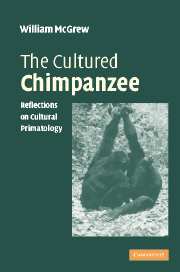Book contents
- Frontmatter
- Contents
- Preface
- Acknowledgements
- 1 Introduction
- 2 Definition
- 3 Disciplines
- 4 Creatures other than primates
- 5 Primates
- 6 Chimpanzee ethnography
- 7 Chimpanzee material culture
- 8 Chimpanzee society
- 9 Lessons from cultural primatology
- 10 Does cultural primatology have a future?
- References
- Author index
- Subject index
7 - Chimpanzee material culture
Published online by Cambridge University Press: 29 December 2009
- Frontmatter
- Contents
- Preface
- Acknowledgements
- 1 Introduction
- 2 Definition
- 3 Disciplines
- 4 Creatures other than primates
- 5 Primates
- 6 Chimpanzee ethnography
- 7 Chimpanzee material culture
- 8 Chimpanzee society
- 9 Lessons from cultural primatology
- 10 Does cultural primatology have a future?
- References
- Author index
- Subject index
Summary
Happily for the cultural primatologist, chimpanzees make use of material culture every day of their lives. Such elementary technology is by far the most accessible manifestation of culture in these apes. Furthermore, material culture by definition leaves a tangible record of its use as an enabler, facilitator, or product of behaviour. However humble or mundane are the objects involved, the scientific advantages of concreteness cannot be overestimated.
Elementary technology is the knowledgeable use of one or more physical objects as a means to achieve an end. I distinguish between technology as elementary when simple, and advanced when complex, using the terms in Oswalt's (1976) sense. This is different from the object being an end in itself. The grapefruit-size fruit of the woody Saba vine may be opened systematically and skilfully (Corp & Byrne, 2002), so that its juicy pulp is eaten, but this is food-processing, not technology. If the same fruit were to be plucked and thrown at a companion, then this use would be technology, for the fruit becomes a missile aimed to strike another. Or, if after consumption of its contents, the empty shell of the fruit were to be used by the ape as a container to collect dripping rainwater, then the item would be transformed into an artefact.
If such technology meets the definitional criteria posed in Chapter 2, then it is material culture. That is, if it is standardized in a collective way that is characteristic of the group, then it is cultural.
- Type
- Chapter
- Information
- The Cultured ChimpanzeeReflections on Cultural Primatology, pp. 103 - 130Publisher: Cambridge University PressPrint publication year: 2004
- 2
- Cited by



